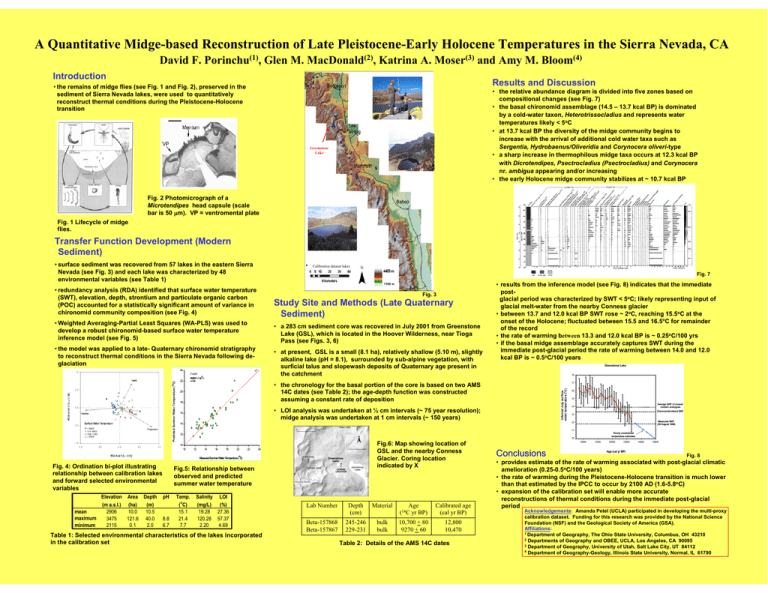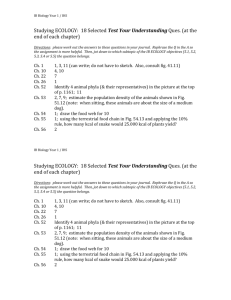Document 13219728
advertisement

A Quantitative Midge-based Reconstruction of Late Pleistocene-Early Holocene Temperatures in the Sierra Nevada, CA David F. Porinchu(1), Glen M. MacDonald(2), Katrina A. Moser(3) and Amy M. Bloom(4) Introduction Results and Discussion • the remains of midge flies (see Fig. 1 and Fig. 2), preserved in the sediment of Sierra Nevada lakes, were used to quantitatively reconstruct thermal conditions during the Pleistocene-Holocene transition • the relative abundance diagram is divided into five zones based on compositional changes (see Fig. 7) • the basal chironomid assemblage (14.5 – 13.7 kcal BP) is dominated by a cold-water taxon, Heterotrissocladius and represents water temperatures likely < 5oC • at 13.7 kcal BP the diversity of the midge community begins to increase with the arrival of additional cold water taxa such as Sergentia, Hydrobaenus/Oliveridia and Corynocera oliveri-type • a sharp increase in thermophilous midge taxa occurs at 12.3 kcal BP with Dicrotendipes, Psectrocladius (Psectrocladius) and Corynocera nr. ambigua appearing and/or increasing • the early Holocene midge community stabilizes at ~ 10.7 kcal BP Greenstone Lake Fig. 2 Photomicrograph of a Microtendipes head capsule (scale bar is 50 µm). VP = ventromental plate Fig. 1 Lifecycle of midge flies. Transfer Function Development (Modern Sediment) • surface sediment was recovered from 57 lakes in the eastern Sierra Nevada (see Fig. 3) and each lake was characterized by 48 environmental variables (see Table 1) • Fig. 7 • redundancy analysis (RDA) identified that surface water temperature (SWT), elevation, depth, strontium and particulate organic carbon (POC) accounted for a statistically significant amount of variance in chironomid community composition (see Fig. 4) Fig. 3 Study Site and Methods (Late Quaternary Sediment) • Weighted Averaging-Partial Least Squares (WA-PLS) was used to develop a robust chironomid-based surface water temperature inference model (see Fig. 5) • a 283 cm sediment core was recovered in July 2001 from Greenstone Lake (GSL), which is located in the Hoover Wilderness, near Tioga Pass (see Figs. 3, 6) • the model was applied to a late- Quaternary chironomid stratigraphy to reconstruct thermal conditions in the Sierra Nevada following deglaciation • at present, GSL is a small (8.1 ha), relatively shallow (5.10 m), slightly alkaline lake (pH = 8.1), surrounded by sub-alpine vegetation, with surficial talus and slopewash deposits of Quaternary age present in the catchment 1:1 r2 = 0.73 o RMSEP=1.16 C n=44 18 15 Average SWT of closest modern analogues 14 Chironomid-infered SWT 13 Measured SWT (09 August 1999) 11 Poorly constrained temperature estimates 12 10 12 14 16 18 20 22 Fig.6: Map showing location of GSL and the nearby Conness Glacier. Coring location indicated by X 24 o MeasuredSummer Water Temperature ( C) 8.8 6.7 16 12 14 Fig.5: Relationship between observed and predicted summer water temperature pH 17 • LOI analysis was undertaken at ½ cm intervals (~ 75 year resolution); midge analysis was undertaken at 1 cm intervals (~ 150 years) 16 10 Elevation Area Depth (m a.s.l.) (ha) (m) mean 2906 10.0 10.5 maximum 3475 121.6 40.0 minimum 2115 0.1 2.0 Greenstone Lake 18 • the chronology for the basal portion of the core is based on two AMS 14C dates (see Table 2); the age-depth function was constructed assuming a constant rate of deposition 20 10 Fig. 4: Ordination bi-plot illustrating relationship between calibration lakes and forward selected environmental variables • results from the inference model (see Fig. 8) indicates that the immediate postglacial period was characterized by SWT < 5oC; likely representing input of glacial melt-water from the nearby Conness glacier • between 13.7 and 12.0 kcal BP SWT rose ~ 2oC, reaching 15.5oC at the onset of the Holocene; fluctuated between 15.5 and 16.5oC for remainder of the record • the rate of warming between 13.3 and 12.0 kcal BP is ~ 0.25oC/100 yrs • if the basal midge assemblage accurately captures SWT during the immediate post-glacial period the rate of warming between 14.0 and 12.0 kcal BP is ~ 0.5oC/100 years Inferred July surface water temperature (oC) Predicted Summer Water Temperature (oC) 24 22 Calibration dataset lakes Temp. (oC) 15.1 21.4 7.7 Salinity LOI (mg/L) (%) 19.28 27.36 120.28 57.37 2.20 4.69 Table 1: Selected environmental characteristics of the lakes incorporated in the calibration set Lab Number Depth (cm) Material Age (14C yr BP) Calibrated age (cal yr BP) Beta-157868 Beta-157867 245-246 229-231 bulk bulk 10,700 + 80 9270 + 60 12,800 10,470 Table 2: Details of the AMS 14C dates 10000 Conclusions 11000 12000 13000 Age (cal yr BP) 14000 15000 Fig. 8 • provides estimate of the rate of warming associated with post-glacial climatic amelioration (0.25-0.5oC/100 years) • the rate of warming during the Pleistocene-Holocene transition is much lower than that estimated by the IPCC to occur by 2100 AD (1.6-5.8oC) • expansion of the calibration set will enable more accurate reconstructions of thermal conditions during the immediate post-glacial period Acknowledgements: Amanda Petel (UCLA) participated in developing the multi-proxy calibration dataset. Funding for this research was provided by the National Science Foundation (NSF) and the Geological Society of America (GSA). Affiliations: 1 Department of Geography, The Ohio State University, Columbus, OH 43210 2 Departments of Geography and OBEE, UCLA, Los Angeles, CA 90095 3 Department of Geography, University of Utah, Salt Lake City, UT 84112 4 Department of Geography-Geology, Illinois State University, Normal, IL 61790




